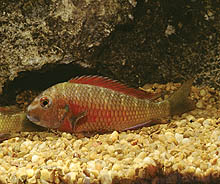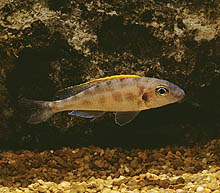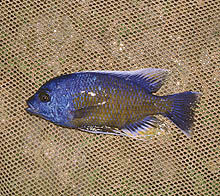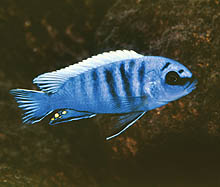WHAT'S NEW ACROSS THE WORLD
What's
new April 2000
What's
new July 2000
What's
new October 2000
What's
new January 2001
What's
new April 2001
What's
new July 2001
What's
new October 2001
What's
new January 2002
| What's New ©by
Laif DeMason
The fish-keeping season is in full swing, and
many importers, exporters, and breeders are actively plying their trade.
Due to the airline industry’s heightened security and worldwide alerts,
many new measures are being introduced which ultimately increase the costs
of shipping. Therefore fishes from many parts of the world will show an
increase in landed costs due to, for example, the price of security measures
for international cargo. To get around these higher costs and slower sales
some of the newer collectors have opted to bypass the usual importers and
sell directly to the consumer. This however has contributed to an increase
in “designer” names and acclimation problems.
Here’s “what’s new” on the cichlid scene: |
Lake Tanganyika
Rains have been heavy over southern sections of the lake this year.
Still, collections from Zambia, Tanzania, and Burundi are strong. Congo
is only sporadically visited, and some recent problems have resulted in
restrictions in fishing. Hopefully this closure will only be temporary.
|
what's new: Lake Tanganyika
|

Collected from Kerenge Island (Tanzania), this Cyprichromis
leptosoma sports blue zebra-like bars. |

Also from southern Tanzania, this strain of Altolamprologus
compressiceps was sold in the late 1980s as “copperhead”, but now occasionally
arrives in groups of the “goldhead” variety. |

Collected in the Congo near Moliro, this red and green
Tropheus
moorii is now available from Zambia. |

From Kapampa (Congo), Xenotilapia papilio “fluorescent”
sports a bright orange dorsal fin and eyering. |
Lake Malawi
Airline pullouts and problems in exporting live fish from Lilongwe (Malawi)
will cause price increases in some parts of the world. Collectors in Malawi
and Tanzania are working hard to sell seasonal items, while Mozambique
is visited sporadically. Bred sources still have full complements of Malawian
varieties.

Wild Champsochromis caeruleus are seasonally
available from the lake but rarely arrive in full color. Photo by C. Kacirek. |

Also seasonally collected, Aulonocara rostratum
is a jumbo-sized peacock species. |

A rarely collected predator, Hemitaeniochromis
urotaenia has been exported from Itungi (Tanzania). Photo by A. Konings. |

Gaining in popularity with breeders of late, Nimbochromis
linni are usually available from wild sources. |

Bred for many years in Florida as “Haplochromis quadrimaculatus”,
this cichlid is really Copadichromis borleyi from Mbenji Island.
Photo by C. Kacirek. |

Exported from southern Tanzania, Pseudotropheus perspicax
sports a light blue ground color with white markings. Photo by A. Konings. |
Victoria
Sadly there’s not much new to report from the Victoria basin. Bred fishes
are still the best source of select species whenever they are available.

Still a very popular fish, “Haplochromis” nyererei
is available in a number of color forms. |
 Dropped as a bred variety on many cichlid farms, the original “Haplochromis”
sp. “thick skin” or “obliquidens” may soon disappear from the hobby.
Dropped as a bred variety on many cichlid farms, the original “Haplochromis”
sp. “thick skin” or “obliquidens” may soon disappear from the hobby. |
Neotropics
Cichlid imports from South America are brisk for the moment. Several
newer varieties of wild Symphysodon discus as well as several rarely
seen cichlids are now being collected. Dwarf Apistogramma from bred
sources are making their way into cichlid shops and gaining popularity.
Neotropical cichlids from central America can be procured from breeders
as usual.

Though not new, Copora nicaraguense from bred
sources show excellent coloration. Photo by J. Rapps. |

Exported from South America, peacock bass like Cichla
ocellaris are sold at small sizes. Photo by M. Smith. |
|











 Dropped as a bred variety on many cichlid farms, the original “Haplochromis”
sp. “thick skin” or “obliquidens” may soon disappear from the hobby.
Dropped as a bred variety on many cichlid farms, the original “Haplochromis”
sp. “thick skin” or “obliquidens” may soon disappear from the hobby.
